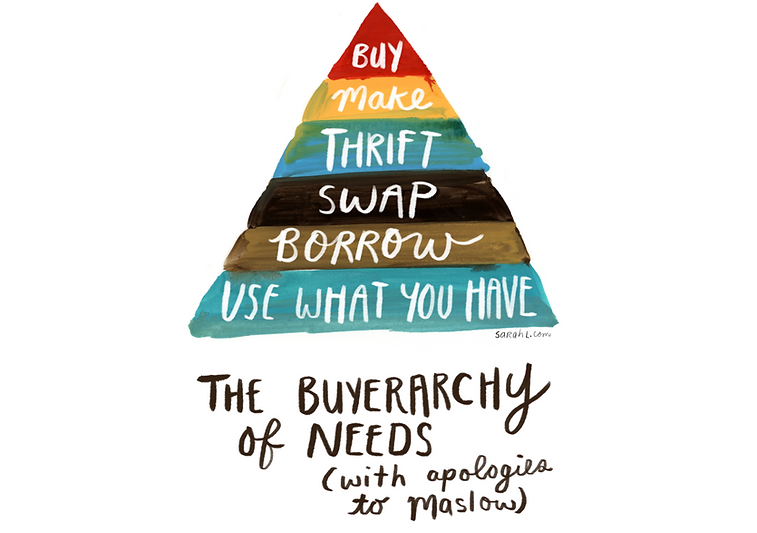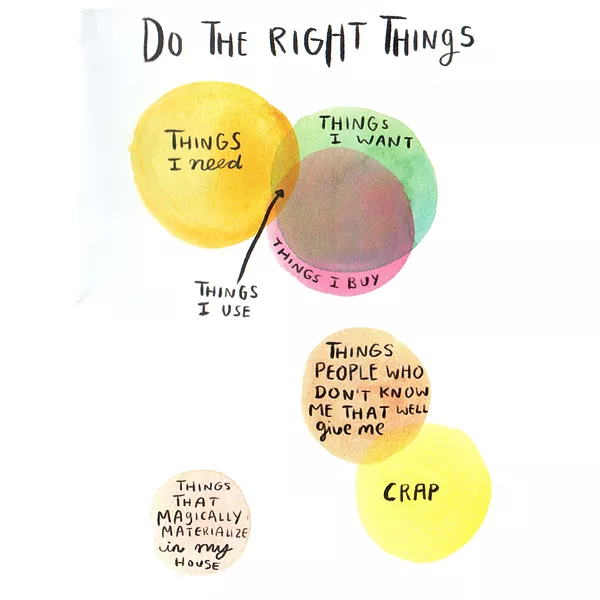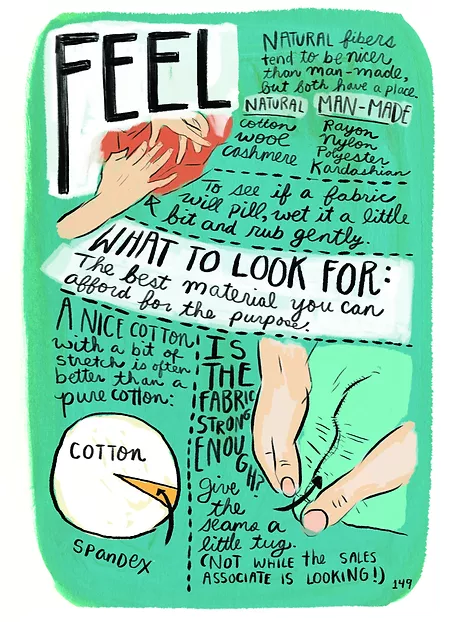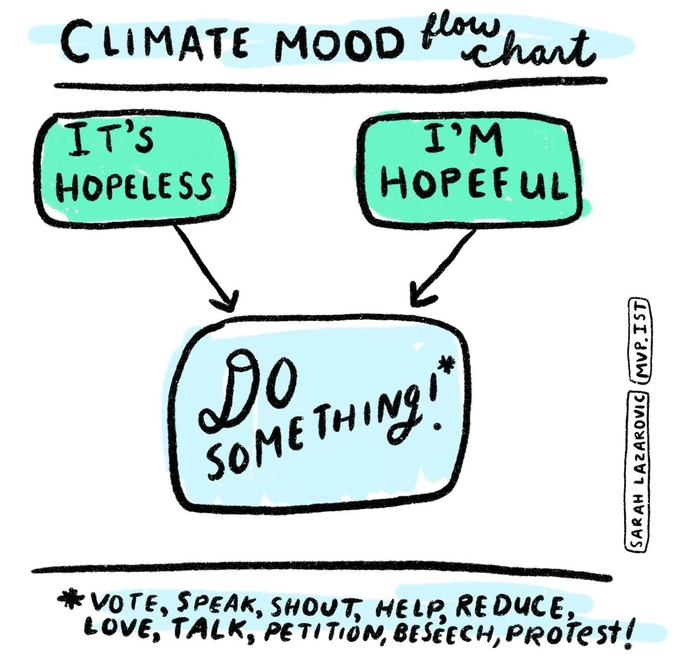Buyerarchy of Needs
The Buyerarchy of Needs can provide reminders on how to save money through the different levels of obtaining wants or needs.

Using what you have, borrowing and swapping, thrift, make and buy
If you have ever taken a psychology class, you may have heard of Maslow’s Hierarchy of Needs, which looks at the structure of needs that influence our choices and behaviors. A newly imagined hierarchy of buying behavior needs has been created by Canadian illustrator Sarah Lazarovic. This “Buyerarchy” looks at buying as the last level after all other areas have been tried. This image is a great way to look at the choices made in buying and to focus on going up the pyramid in how items are obtained that we need or want. The goal in utilizing the “Buyerarchy of Needs” is to save money and keep it for future purchases where buying is the only option.
Using what you have
While it might seem obvious, this base-level buyerarchy need looks at making good use of what you already have. Stop and think: do I already have the item or tool to achieve this goal or purpose? Being organized with your current items helps with this. If you can find the items you have, you can use them. It is also important to keep your belongings in good order. Don’t use and abuse your possessions. Take care of things so they will last a long time and make good use of your purchases. Use the food and supplies you already have before getting more.
Borrow
Another way to make your money last is by using an item temporarily and then returning it. Consider if there is a place or person from whom you can borrow this item. Libraries are great for borrowing books, movies, music and sometimes even kits or tools. Friends or family might have a piece of equipment, interview clothes or a cooking supply that you can borrow instead of spending the money to use for a limited purpose.
Swap
This is a near cousin to borrow. Ask yourself if there is something you can trade to obtain this item. Do you know someone who might have the item you are looking for and might be willing to swap with something you have? Trade a video game that you are done playing with a friend for a new game or movie. Finished with a purse or clothing accessory? Someone you know also has an accessory that they can swap with you to enhance each of your wardrobes without spending money. Use freecycle.org to share your old items or swap for someone else’s items as part of a community of sharing, or consider hosting a swapping event with your friends. Keep in mind, your “traded” item could be a service. Help your cousin with moving and ask if you can have their old desk.
Thrift
This is a form of buying, but a lower-cost option. There are two levels: buying for yourself or selling so you can have the finances for a future purchase. Thrift or second-hand stores often offer good quality clothes, kitchenware and furniture options. Some pieces may require a small bit of work, but can be cheaper in the long run. Shopping garage sales can also be a great plan as well as searching online selling options. The key is to focus on what you need, not what you want. The second option, selling, is a way to bring in a bit of income from your used items. Someone else might benefit from your old chair, sweater or kid’s toys.
Make
Making an item can involve cost, but can end up saving money from outright buying the ready-made product. The questions to consider are, “What ways can I make or do this myself? Will that save money? Can I repurpose an item, such as a sweater, into something else, like a tote bag?” Doing projects yourself at home can save money. It might take a little time, but you can learn easy ways to fix small repairs at home, redo a room or create your own artwork. Making lunch to take to work is cheaper, and often healthier, than eating out. This is true for dinner too!
Making also applies to party decorations, gifts, cards and other products that you may have chosen to purchase in the past. Making items allows for more personalization and creativity as well!
Buy
Only after you have exhausted the bottom levels of the Buyerarchy of Needs, it may be time to buy. There are still wise ways to spend that money. Shop around for good prices including getting quotes from multiple vendors for larger projects. Use generic brands for your food or pharmacy purchases. Use cost-saving techniques such as not having cable. Make a list of food you are buying before you go to the grocery store and only buy from the list. Cut coupons and use deals for purchases. Think about what you need versus what you want.
There are many ways to save to money even when you have to actually buy the item. The best bet is to save up your money to buy the item rather than charging on a credit card and risking finance fees. The key point is to make sure you have the money before you buy.
The Buyerarchy of Needs image can be posted somewhere you can see it, even next to your computer, to help remind you to think through other options before buying.
Sarah Lazarovic, Canada

PROFILE
Creative Director and illustrator, strategist, writer, and designer.
Sarah spent 2015 studying behavioural economics and sustainability, where she applied behavioural insights to design, from public policy to consumer products. Her research focus was on behavioural design for sustainability.
In 2014, she wrote a book: A Bunch of Pretty Things I Did Not Buy. It’s available at fine libraries everywhere.
Main Research Source
- Buyerarchy of Needs: Using what you have, borrowing and swapping | Laurie Rivetto(06/04/2015)
- Thrift, make and buy: The top levels of the Buyerarchy of Needs | Laurie Rivetto(07/07/2015)
This Buyerarchy of Needs illustration presents a new way of finding what we need. The first level, using what you have, is the highest priority whilst buying is the last level, after all other options have been exhausted.
This framework can be applied to almost anything you would usually buy and is a great way of saving money.
Many people are applying this idea to think about their clothing;
- less is more
- buy clothes made to last
- conscious buying is a top level need




